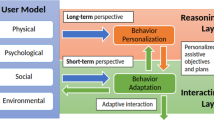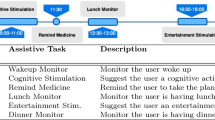Abstract
Socially assistive robotics aims at providing users with continuous support and personalized assistance, through appropriate social interactions. The design of robots capable of supporting people in heterogeneous tasks, raises several challenges among which the most relevant are the need to realise intelligent and continuous behaviours, robustness and flexibility of services and, furthermore, the ability to adapt to different contexts and needs. Artificial intelligence plays a key role in realizing cognitive capabilities like e.g., learning, context reasoning or planning that are highly needed in socially assistive robots. The integration of several of such capabilities is an open problem. This paper proposes a novel “cognitive approach” integrating ontology-based knowledge reasoning, automated planning and execution technologies. The core idea is to endow assistive robots with intelligent features in order to reason at different levels of abstraction, understand specific health-related needs and decide how to act in order to perform personalized assistive tasks. The paper presents such a cognitive approach pointing out the contribution of different knowledge contexts and perspectives, presents detailed functioning traces to show adaptation and personalization features, and finally discusses an experimental assessment proving the feasibility of the approach.













Similar content being viewed by others
Notes
The reasoning processes have been developed using the open-source Apache Jena library—https://jena.apache.org.
References
Allen SM, Foster A, Berg K (2001) Receiving help at home. The interplay of human and technological assistance. J Gerontol Ser B 56(6):S374–S382
Anderson JR, Matessa M, Lebiere C (1997) ACT-R: a theory of higher level cognition and its relation to visual attention. Hum Comput Interact 12(4):439–462
Awaad I, Kraetzschmar GK, Hertzberg J (2015) The role of functional affordances in socializing robots. Int J Soc Robot 7(4):421–438
Bayat B et al (2016) Requirements for building an ontology for autonomous robots. Ind Robot Int J Robot Res Appl 43(5):469–480
Berlin M, Gray J, Thomaz AL, Breazeal C (2006) Perspective taking: an organizing principle for learning in human–robot interaction. In: AAAI, pp 1444–1450
Bertolini A, Salvini P, Pagliai T, Morachioli A, Acerbi G, Trieste L, Cavallo F, Turchetti G, Dario P (2016) On robots and insurance. Int J Soc Robot 8(3):381–391
Borgo S (2014) An ontological approach for reliable data integration in the industrial domain. Comput Ind 65(9):1242–1252 Special Issue on The Role of Ontologies in Future Web-based Industrial Enterprises
Borgo S, Carrara M, Garbacz P, Vermaas P (2009) A formal ontological perspective on the behaviors and functions of technical artifacts. Artif Intell Eng Des Anal Manuf 23(1):3–21
Borgo S, Cesta A, Orlandini A, Umbrico A (2016) A planning-based architecture for a reconfigurable manufacturing system. In: ICAPS, the 26th international conference on automated planning and scheduling
Borgo S, Cesta A, Orlandini A, Umbrico A (2019) Knowledge-based adaptive agents for manufacturing domains. Eng Comput 35(3):755–779
Casey D, Felzmann H, Pegman G, Kouroupetroglou C, Murphy K, Koumpis A, Whelan S (2016) What people with dementia want: designing MARIO an acceptable robot companion. In: Miesenberger K, Bühler C, Penaz P (eds) Computers helping people with special needs. Springer, New York, pp 318–325
Cesta A, Cortellessa G, Fracasso F, Orlandini A, Turno M (2018) User needs and preferences on AAL systems that support older adults and their carers. J Ambient Intelli Smart Environ 10(1):49–70
Cesta A, Cortellessa G, Giuliani MV, Pecora F, Scopelliti M, Tiberio L (2007) Psychological implications of domestic assistive technology for the elderly. Psychnol J 5(3):229–252
Cesta A, Cortellessa G, Orlandini A, Sorrentino A, Umbrico A (2019) A semantic representation of sensor data to promote proactivity in home assistive robotics. In: Arai K, Kapoor S, Bhatia R (eds) Intelligent systems and applications. Springer, Cham, pp 750–769
Cesta A, Cortellessa G, Orlandini A, Umbrico A (2018) A cognitive loop for assistive robots - connecting reasoning on sensed data to acting. In: RO-MAN. The 27th IEEE international symposium on robot and human interactive communication, pp 826–831
Cesta A, Cortellessa G, Pecora F, Rasconi R (2007) Supporting interaction in the ROBOCARE intelligent assistive environment. In: AAAI spring symposium: interaction challenges for intelligent assistants, pp 18–25
Charness N (2003) Impact of technology on successful aging. Springer, New York
Cialdea Mayer M, Orlandini A, Umbrico A (2016) Planning and execution with flexible timelines: a formal account. Acta Inform 53(6–8):649–680
Compton M, Barnaghi P, Bermudez L, García-Castro R, Corcho O, Cox S, Graybeal J, Hauswirth M, Henson C, Herzog A, Huang V, Janowicz K, Kelsey WD, Phuoc DL, Lefort L, Leggieri M, Neuhaus H, Nikolov A, Page K, Passant A, Sheth A, Taylor K (2012) The SSN ontology of the W3C semantic sensor network incubator group. Web Semant Sci Serv Agents World Wide Web 17(C):25–32
Coradeschi S, Cesta A, Cortellessa G, Coraci L, Gonzalez J, Karlsson L, Furfari F, Loutfi A, Orlandini A, Palumbo F, Pecora F, von Rump S, Štimec A, Ullberg J, Ötslund B (2013) GiraffPlus: combining social interaction and long term monitoring for promoting independent living. In: The 6th international conference on human system interactions (HSI), pp 578–585
D’Onofrio G, Sancarlo D, Ricciardi F, Ruan Q, Yu Z, Giuliani F, Greco A (2016) Cognitive stimulation and information communication technologies (ICT) in Alzheimer’s diseases: a systematic review. Int J Med Biol Front 22(2):97
El Kamali M, Angelini L, Caon M, Andreoni G, Khaled OA, Mugellini E (2018) Towards the NESTORE e-coach. In: proceedings of the 2018 ACM international joint conference and 2018 international symposium on pervasive and ubiquitous computing and wearable computers—UbiComp ’18
Feil-Seifer DJ, Matarić MJ (2005) Defining socially assistive robotics. In: 9th International conference on rehabilitation robotics. ICORR 2005, pp 465–468
Fiorini SR, Bermejo-Alonso J, Gonçalves P, Pignaton de Freitas E, Olivares Alarcos A, Olszewska JI, Prestes E, Schlenoff C, Ragavan SV, Redfield S, Spencer B, Li H (2017) A suite of ontologies for robotics and automation [industrial activities]. IEEE Robot Autom Mag 24(1):8–11
Fong T, Nourbakhsh I, Dautenhahn K (2003) A survey of socially interactive robots. Robot Auton Syst 42(3):143–166. https://doi.org/10.1016/S0921-8890(02)00372-X
Gangemi A, Presutti V (2009) Ontology design patterns. In: Staab S, Studer R (eds) Handbook on ontologies. Springer, Berlin, pp 221–243
Ghallab M, Nau D, Traverso P (2014) The actor’s view of automated planning and acting: a position paper. Artif Intell 208:1–17
Ghidini C, Giunchiglia F (2001) Local models semantics, or contextual reasoning = locality + compatibility. Artif Intell 127(2):221–259
Group AW et al (2012) The 2012 ageing report: economic and budgetary projections for the 27 EU member states (2010–2060). Joint Report European Commission and Economic Policy Committee, p 2
Guha R, McCool R (2003) TAP: a semantic web platform. Comput Netw 42(5):557–577
Hellstrom Y, Hallberg IR (2001) Perspectives of elderly people receiving home help on health, care and quality of life. Health Soc Care Commun 9(2):61–71
Ingrand F, Ghallab M (2017) Deliberation for autonomous robots: a survey. Artif Intell 247:10–44
Iwarsson S (2005) A long-term perspective on person-environment fit and ADL dependence among older Swedish adults. Gerontologist 45(3):327–336
Janowicz K, Compton M (2010) The stimulus-sensor-observation ontology design pattern and its integration into the semantic sensor network ontology. In: Proceedings of the 3rd international conference on semantic sensor networks, vol 668, SSN’10. CEUR-WS.org, Aachen, pp 64–78
Klein BE, Klein R, Knudtson MD, Lee KE (2005) Frailty, morbidity and survival. Arch Gerontol Geriatr 41(2):141–149
Laird JE, Newell A, Rosenbloom PS (1987) SOAR: an architecture for general intelligence. Artif Intell 33(1):1–64
Langley P, Laird JE, Rogers S (2009) Cognitive architectures: research issues and challenges. Cognit Syst Res 10(2):141–160
Lemaignan S, Ros R, Mosenlechner L, Alami R, Beetz M (2010) ORO, a knowledge management platform for cognitive architectures in robotics. In: 2010 IEEE/RSJ international conference on intelligent robots and systems (IROS), pp 3548–3553
Mataric M, Tapus A, Feil-Seifer D (2007) Personalized socially assistive robotics. In: Workshop on intelligent systems for assisted cognition
Matarić MJ, Scassellati B (2016) Socially assistive robotics. In: Siciliano B, Khatib O (eds) Springer handbook of robotics. Springer, New York, pp 1973–1994
McCarthy J (1993) Notes on formalizing context. In: Proceedings of the 13th international joint conference on artificial intelligence, IJCAI’93. Morgan Kaufmann Publishers Inc, pp 555–560
Moro C, Nejat G, Mihailidis A (2018) Learning and personalizing socially assistive robot behaviors to aid with activities of daily living. ACM Trans Hum Robot Interact 7(2):15:1–15:25
Olszewska JI, Barreto M, Bermejo-Alonso J, Carbonera J, Chibani A, Fiorini S, Goncalves P, Habib M, Khamis A, Olivares A, de Freitas EP, Prestes E, Ragavan SV, Redfield S, Sanz R, Spencer B, Li H (2017) Ontology for autonomous robotics. In: 26th IEEE international symposium on robot and human interactive communication (RO-MAN), pp 189–194
Olszewska JI, Houghtaling M, Gonçalves P, Haidegger T, Fabiano N, Carbonera JL, Fiorini SR, Prestes E (2018) Robotic ontological standard development life cycle. In: Workshop on elderly care robotics-technology and ethics: IEEE ICRA 2018 workshop program. Brisbane Convention & Exhibition Centre, Brisbane
Pineau J, Montemerlo M, Pollack M, Roy N, Thrun S (2003) Towards robotic assistants in nursing homes: challenges and results. Robot Auton Syst 42(3):271–281
Pollack ME (2005) Intelligent technology for an aging population: the use of AI to assist elders with cognitive impairment. AI Magazine 26(2):9
Pollack ME, Brown L, Colbry D, Orosz C, Peintner B, Ramakrishnan S, Engberg S, Matthews JT, Dunbar-Jacob J, McCarthy CE et al (2002) Pearl: a mobile robotic assistant for the elderly. In: AAAI workshop on automation as caregiver
Rajan K, Saffiotti A (2017) Towards a science of integrated AI and robotics. Artif Intell 247:1–9
Roberts M, Shivashankar V, Alford R, Leece M, Gupta S, Aha DW (2016) Goal reasoning, planning, and acting with ActorSim, the actor simulator. In: Proceedings of the conference on advances in cognitive systems
Rossi S, Ferland F, Tapus A (2017) User profiling and behavioral adaptation for HRI: a survey. Pattern Recogn Lett 99:3–12
Smith D, Frank J, Jonsson A (2000) Bridging the gap between planning and scheduling. Knowl Eng Rev 15(1):47–83
Suh IH, Lim GH, Hwang W, Suh H, Choi JH, Park YT (2007) Ontology-based multi-layered robot knowledge framework (OMRKF) for robot intelligence. In: IEEE/RSJ international conference on intelligent robots and systems. IROS 2007, pp 429–436
Tapus A, Mataric MJ, Scassellati B (2007) Socially assistive robotics [grand challenges of robotics]. IEEE Robot Autom Mag 14(1):35–42. https://doi.org/10.1109/MRA.2007.339605
Tenorth M, Beetz M (2015) Representations for robot knowledge in the KnowRob framework. Artif Intell 247:151–169
Umbrico A, Cesta A, Cialdea Mayer M, Orlandini A (2017) PLATINUm: a new framework for planning and acting. Lecture notes in computer science, pp 498–512
Umbrico A, Cesta A, Cortellessa G, Orlandini A (2018) A goal triggering mechanism for continuous human–robot interaction. In: Ghidini C, Magnini B, Passerini A, Traverso P (eds) AI*IA 2018—advances in artificial intelligence. Springer, Cham, pp 460–473
World Health Organization (2001) International classification of functioning, disability and health. ICF
Acknowledgements
The authors would like to express their gratitude to Stefano Borgo whose collaboration in a different project [10] turned out being influential for their approach in the research direction described in this paper.
Funding
At present, authors are partially supported by the SI-Robotics project - “SocIal ROBOTICS for active and healthy ageing”. A project funded by the Italian Ministry for Education and Research (PON MIUR - PNR 2015-2020): Area “Technology enhanced living environments”.
Author information
Authors and Affiliations
Corresponding author
Ethics declarations
Conflict of Interest
The authors declare to have no conflict of interest.
Additional information
Publisher's Note
Springer Nature remains neutral with regard to jurisdictional claims in published maps and institutional affiliations.
Rights and permissions
About this article
Cite this article
Umbrico, A., Cesta, A., Cortellessa, G. et al. A Holistic Approach to Behavior Adaptation for Socially Assistive Robots. Int J of Soc Robotics 12, 617–637 (2020). https://doi.org/10.1007/s12369-019-00617-9
Accepted:
Published:
Issue Date:
DOI: https://doi.org/10.1007/s12369-019-00617-9




